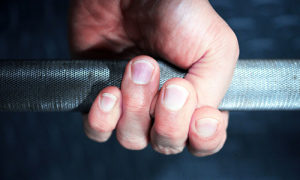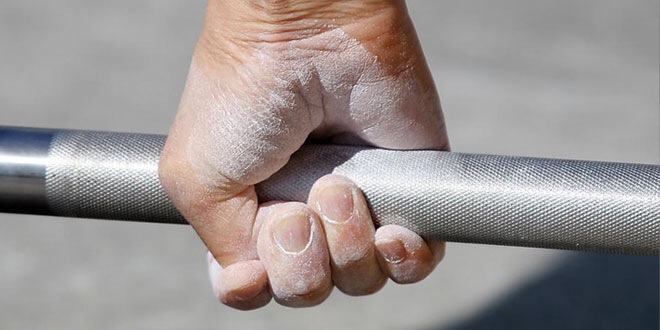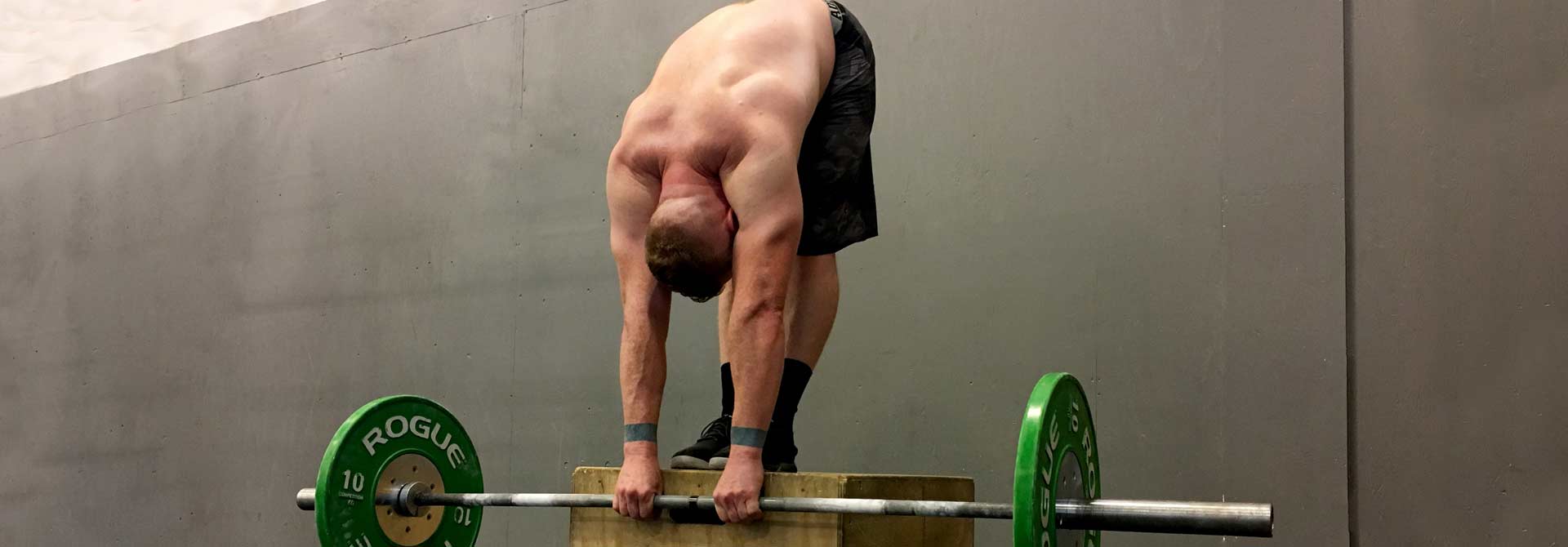The hook grip has been in use in the Olympic weightlifting community for decades. Used for very heavy pulls and on-stage competition, the hook grip is pretty simple but brutal, and is essentially limitless.
What I mean by that is that when you’re pulling a snatch or a clean and jerk, it’s rarely your grip that causes you to fail to make the lift.
Likewise, someone who specializes and utilizes the hook grip for years typically won’t struggle to max out their deadlift on comp day due to grip problems.
You can totally hit the ceiling for the hook grip on something like a max rack pull or high-rep weightlifting, but it’s a great way to do triple and max deadlift sets without straps. Why bother not using straps, you ask?
You can’t use straps in an official powerlifting meet. At least, not yet. Arguments for and against straps have been going back and forth online for years, but it’s generally not likely that federations are going to start letting deadlift straps into the game.
This means your choices are simple: go for the overhand, go for the mixed grip, or go for the hook grip. The hook grip is vastly superior to the other two if trained regularly – and you don’t even need big hands to do it. All you need is a little pain tolerance and some chalk. This isn’t particularly good advice for advanced lifters, because chances are they’ve found their perfect setup. But if you’re a novice or intermediate lifter, use the hook grip.
What is a Hook Grip?
The hook grip simply involves wrapping your thumb around the bar, and subsequently wrapping both your index and middle finger over your thumb. This might sound like an incredibly minimal difference from a regular overhand grip, but if you understand how the bar attempts to slip out of an overhand grip, you can understand why the hook grip is so effective.
When you grip a barbell in an overhand position (palms facing you) and then attempt to deadlift it, it’s going to spin. While your four fingers hold the bar, your thumb and palm are squeezing to keep the bar from spinning. If it’s too heavy, it’ll spin out of your hand. This spin isn’t because the bar is inherently spinning – it’s just a natural limitation of the overhand grip.
The same thing happens in a dead hang – go and grip a pullup bar, and just hang. You’ll notice that as your grip gradually slips, what happens first is that you struggle to maintain contact between the thumb and the bar. Eventually, you’re holding on with your fingertips. Your hands roll off the bar, and you drop to the ground.
How to Grip the Bar Properly
The hook grip simply applies two things to improve your grip massively: reduced spin, and a better ridge for your fingers.
With these two concepts, you’ll be able to understand why the hook grip – which is really just a tiny change involving placing your thumb under your fingers rather than over them – is so useful.
- Reduced Spin – by squeezing your thumb into the barbell, you’re essentially placing a doorstop on the bar. The skin on your thumb will dig into the knurling and prevent the bar from rolling. Meanwhile, you’re clamping down on your thumb with your fingers. As the bar pulls your fingers down, more pressure is applied to the thumb, which applies more friction. This creates a self-locking mechanism that eliminates bar spin.
- Better Ridge – the thumb on the bar makes it easier to grab than just the bar. Try it with other things. Hold your groceries or bag with a hook grip. You’ll notice that it’s easier to maintain a tighter grip with less force, thanks to the thumb. Your hands will naturally adjust your hook grip to maximize comfort and effectiveness once you get used to the friction on the thumb, allowing for a more efficient and less strenuous grip.
In short – the hook grip gives your fingers a more advantageous way to hold onto the barbell. Yes, it’ll hurt at first. And it’s important to understand why it helps so you can learn to set it up properly.
Does Hand Size Matter?
One thing that’s important to note is that there is a minimum hand size for a solid hook grip. I don’t have the freakiest or largest hands in the world, but my hands aren’t small either.
If I stretch my fingers out and try to create as much distance between the tip of my index finger and the tip of my thumb – the two points that have to meet when I wrap around the bar – I have over 8.5 inches of distance on my left hand, and 8 inches of distance on my right hand.
I dislocated my thumb on my left hand when I was very young, and since then it’s healed with far greater flexibility than on my right. The advantage is obvious after over an hour of deadlifting, when I feel my right hand fatiguing long before the left – not enough to drop the weight, but enough to notice the difference.
The longer the distance between the tip of your thumb and the tip of your index finger, the easier it’ll be for you to get a solid hook grip. If you’ve got small hands, then it’ll be tougher.
I don’t know the exact minimum length, but your mileage will vary anyway. To test if you can viably use the hook grip, simply wrap your thumb around the bar and try and get your index finger and middle finger over the ridge of your thumb’s first knuckle, like this:

If you can do that, then your hands are big enough. It’ll just take time to get used to it.
Hook Grip vs. Mixed Grip
By far the most popular deadlift grip for gym bros all over the planet is the mixed grip. Now, there’s no arguing that the mixed grip isn’t effective.
Have you ever seen Larry Wheels pick up over 700 pounds like it was 70 pounds? It works, and it works well – but it has a very worrying caveat that every novice and intermediate lifter must consider.
A mixed grip is an unbalanced grip. It’s meant to keep the bar from rolling, but you’re getting that benefit at the cost of a high chance of bicep tearing, and improper loading throughout the body.
By employing a mixed grip, you’re essentially keeping the bar from rolling out of your hands, but you’re also building imbalances. If you don’t like deadlifting and barely do it, that’s not a big deal. If deadlifts are important to you – which they should be, if you’re powerlifting or just want to be really strong – then you’ll want to learn how to switch from the mixed grip to the hook grip.
If you can’t hook grip, then it’s not a bad thing to mixed grip for maxes. Try to train in straps and use your mixed grip sparingly and consider assistance work to even out potential imbalances.
Using it for Other Things
The hook grip is great for heavy deadlifts, because they’re usually short, sweet, and don’t involve a lot of explosive bar movement. This means that the skin on your thumb can rest easy and won’t have to worry too much about coming off due to any sudden movements.
But if you’re getting accustomed to doing deadlifts with a hook grip, don’t stop there. I tend to hook grip my farmer’s walks when I’m getting tired, because as fun as it is to fry your forearms and train your grip, your core and traps tend to have a little more gas than your forearms would.
If you’re struggling to keep the weights in your hand during long farmer’s walks, start using the hook grip. This is very easy to do with dumbbells, but some farmer’s grips might be too fat to properly use the hook grip. In that case, you’ll just have to do them more often and get bigger forearms.
I generally don’t use the hook grip for rows or pullups, but that doesn’t mean you can’t. If you’re rowing for reps and don’t want your grip to impede you, the hook grip can help.
Tips for the Grip
The hook grip will be painful the first few times, and there’s no working around that. But you can reduce the effects of the pain by sticking your hand in some ice afterward. This helps with recovery and cools down the hand, so you don’t get that throbbing sensation for hours.
Another thing to keep in mind is that chalk helps a lot. The benefits of the hook grip lie in its ability to produce a lot of friction, and chalk takes all the moisture out of your skin, so the friction is turned up to 11.
This makes it a lot easier to apply the grip, too. Remember that you don’t need to cake your hand in chalk – in fact, this is a terrible practice because the excess chalk fills the holes in the knurling and makes the bar smoother. Rub the chalk into your palm to remove sweat, then perform the lift. Simple.
Finally, if you’re still ripping your skin open, use elastic athletic tape or a special thumb sleeve for hook gripping. It’s important to use elastic material, like elastic tape or gauze, because stiff athletic tape can keep the thumb in a compromised position and keeps it from readjusting as the weight on the bar increases during the initial lift, increasing the risk of tendon damage or dislocation.
Better Hook Grip, Better Pull
It’s a simple equation. The better you are at something, the better you perform when doing it. But with the hook grip, there’s more to it than just tolerating the pain. As you get better and better at customizing your thumb placement and making use of the ridge that the thumb provides to hold onto the barbell, you’ll require less and less forearm activation.
The trick with a perfect hook grip is that it’s much like the strap – you don’t really have to squeeze too much. This gives you more room to dedicate to the activation of your legs and back. Why does this matter?
Because your brain can only do so much, and to maximize your lift, you want most of your brain power to be concentrating on getting your legs to fire rather than squeezing the shit out of the bar.
The easier the hook grip gets, the more you can focus on pushing the world down and lifting the weight up.




